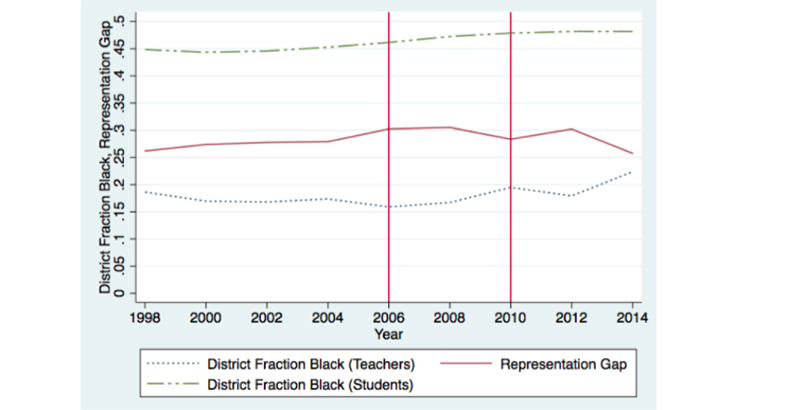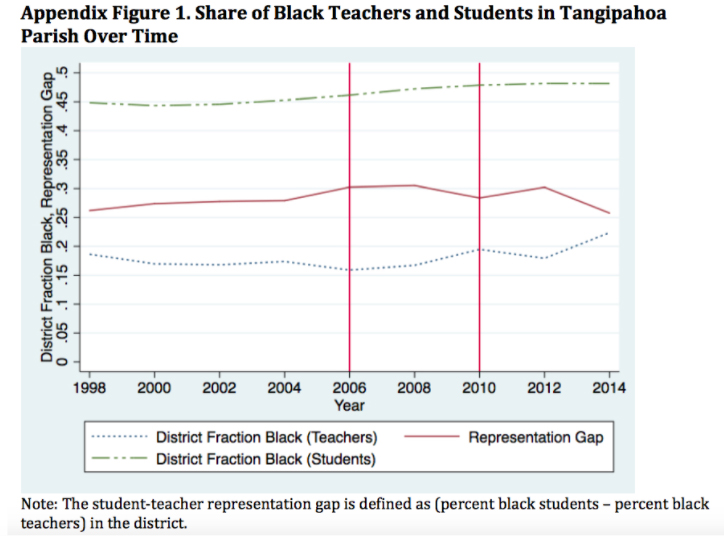Forty Years After Court Order, a Louisiana County Is Finally Hiring More Black Teachers. Student Performance Remains Unchanged

According to a new study published by the National Bureau of Economic Research, a court-ordered program to desegregate the teacher workforce in a Louisiana county succeeded in increasing the share of black teachers hired and lowering the student-teacher “representation gap,” i.e., the relative lack of black teachers compared to black students.
Notably, however, as teaching staffs gradually became more diverse, student achievement was unaffected.
The study, conducted by Northwestern University academics Diane Schanzenbach and Cynthia DuBois, introduces compelling new findings around hiring practices at a time when more observers are touting the benefits of black students learning under same-race teachers. A report released this spring found that black students exposed to even one black teacher were less likely to drop out of high school and more likely to aspire to attend college.
Although existing research indicates that black educators may have higher expectations of their black students, and that the students themselves draw inspiration from seeing their own race reflected in school staff, this newest study provides no evidence of a corresponding boost in standardized test scores.
The authors examined the efforts to change the racial complexion of the teaching workforce in Tangipahoa Parish, a county of roughly 130,000 residents that sits across Lake Pontchartrain from New Orleans. Following a 1969 discrimination lawsuit brought against the local school district by a group of black teachers and coaches, a U.S. district court ordered the enforcement of a comprehensive affirmative action plan mandating a 40:60 ratio of black employees to white ones. Within a few years, however, the school board was held in contempt for refusing to comply, and the order went largely ignored for over three decades.
The suit’s original plaintiffs and attorneys from the NAACP succeeded in having the court reopen the case in 2006, ultimately leading to a new desegregation plan being implemented. Anytime a teaching vacancy occurs at a school in Tangipahoa Parish, the principal is now forwarded a list of qualified black candidates from the district and instructed to select from the group. If no black candidate is hired, the principal must submit an explanation.

As expected, the new policy led to increased hiring of minority candidates. Using data from the Equal Employment Opportunity Commission, Schanzenbach and DuBois found that Tangipahoa Parish’s percentage of black teachers — which had previously been five percentage points lower than the statewide average — had increased substantially, and the percentage of black employees among its new hires was much greater than that of the state as a whole (32.2 percent versus 21.7 percent).
“The overall black teacher employment share was slightly decreasing before the reopening of [the desegregation suit], even as the new teacher hiring share was increasing,” they write. “The share of black teachers rose from 15.9 percent after the Moore case was reopened, to 19.5 percent after the introduction of the court-ordered hiring criteria, and continuing to climb to 22.4 percent by the end of the sample period.” In spite of the fact that the percentage of black students in the district increased slightly over the period of study, so many black teachers were hired that the representation gap still declined by between three and four percentage points.
They also note that the existence of these relatively strict affirmative action measures, which have tended to draw criticism from existing employees in many settings, did not diminish the perception of teacher quality in new hires across the county. After the reforms were implemented, over half of teachers said they believed the overall quality of teachers in their department was increasing, while around one-quarter said that it was decreasing.
If the quality of instruction at the schools either improved or declined, it was not indicated in student achievement data. Results from end-of-course exams in English, math, social studies, and science showed that student performance was neither helped nor hurt by the introduction of diversity hiring practices.
Get stories like these delivered straight to your inbox. Sign up for The 74 Newsletter

;)
